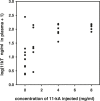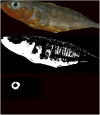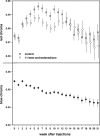Androgen Elevation Accelerates Reproductive Senescence in Three-Spined Stickleback
- PMID: 34977010
- PMCID: PMC8718761
- DOI: 10.3389/fcell.2021.752352
Androgen Elevation Accelerates Reproductive Senescence in Three-Spined Stickleback
Abstract
Costs of reproduction shape the life-history evolution of investment in current and future reproduction and thereby aging. Androgens have been proposed to regulate the physiology governing these investments. Furthermore, androgens are hypothesized to play a central role in carotenoid-dependent sexual signaling, regulating how much carotenoids are diverted to ornamentation and away from somatic maintenance, increasing oxidative stress, and accelerating aging. We investigated these relationships in male three-spined stickleback in which we elevated 11-ketotestosterone and supplied vitamin E, an antioxidant, in a 2 × 2 design. Androgen elevation shortened the time stickleback maintained reproductive activities. We suspect that this effect is caused by 11-ketotestosterone stimulating investment in current reproduction, but we detected no evidence for this in our measurements of reproductive effort: nest building, body composition, and breeding coloration. Carotenoid-dependent coloration was even slightly decreased by 11-ketotestosterone elevation and was left unaffected by vitamin E. Red coloration correlated with life expectancy and reproductive capacity in a quadratic manner, suggesting overinvestment of the individuals exhibiting the reddest bellies. In contrast, blue iris color showed a negative relationship with survival, suggesting physiological costs of producing this aspect of nuptial coloration. In conclusion, our results support the hypothesis that androgens regulate investment in current versus future reproduction, yet the precise mechanisms remain elusive. The quadratic relationships between sexual signal expression and aspects of quality have wider consequences for how we view sexual selection on ornamentation and its relationship with aging.
Keywords: aging; carotenoid; fecundity; sexual hormone; sexual selection; signaling; stickleback.
Copyright © 2021 Simons, Sebire, Verhulst and Groothuis.
Conflict of interest statement
The authors declare that the research was conducted in the absence of any commercial or financial relationships that could be construed as a potential conflict of interest.
Figures








References
-
- Abrams P. A. (1991). The Fitness Costs of Senescence: The Evolutionary Importance of Events in Early Adult Life. Evol. Ecol. 5, 343–360. 10.1007/bf02214152 - DOI
-
- Alonso-Alvarez C., Cantarero A., Romero-Haro A. Á., Chastel O., Pérez-Rodríguez L. (2020). Life-Long Testosterone and Antiandrogen Treatments Affect the Survival and Reproduction of Captive Male Red-Legged Partridges (Alectoris rufa). Behav. Ecol. Sociobiol. 74, 98. 10.1007/s00265-020-02878-1 - DOI
-
- Augustine Jacqueline, K., Millspaugh Joshua, J., Sandercock, Brett K. (2011). “Chapter Fourteen. Testosterone Mediates Mating Success in Greater Prairie-Chickens,” in Ecology, Conservation, and Management of Grouse: Published for the Cooper Ornithological Society. Editors Brett K. S., Kathy Martin, Gernot Segelbacher. (Berkeley: University of California Press; ), 195–208. 10.1525/9780520950573-016 - DOI
-
- Barber I. (2001). Nests as Ornaments: Revealing Construction by Male Sticklebacks. Behav. Ecol. 12, 390–396. 10.1093/beheco/12.4.390 - DOI
LinkOut - more resources
Full Text Sources

